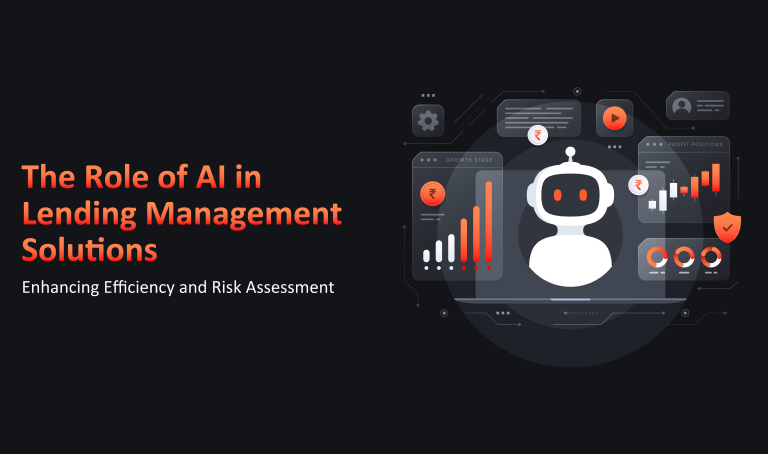Artificial intelligence has become a game-changer, especially within the fast-evolving lending management space. Considering that the worldwide AI in lending market is expected to reach $58 billion by 2033, with an attractive CAGR of 23.5%, lenders are increasingly adopting this technology to make their operations more efficient and better serve their customers.
The Growing Need for AI in Lending
While traditional loan origination has never faced challenges in the form of heightened customer expectations, stringent compliance mandates, increased application volumes and sophisticated fraud threats, the situation is quite different today. Manual verifications and legacy infrastructure can't keep up with modern banking needs. Financial institutions that rely on traditional document verification methods, eligibility assessments, and fraud detection are increasingly losing their competitive edge.
Key Use Cases of AI in Lending Management
1. Enhanced Credit Scoring
Traditional credit scoring is limited in many ways. It relies wholly on historical data regarding financial transactions; thus, it severely penalizes new customers who have little or no credit history despite being genuinely entitled to good credit. AI-based credit scoring systems go much further and consider current income levels, potential earnings, and employment opportunities to build a more accurate picture of a borrower's financial condition.
This significantly enhances financial inclusion by providing access to credit to population segments that were previously underserved.
2. Streamlined Loan Approval
The traditional process of loan approval is cumbersome and consumes a lot of resources. A loan officer has to individually gather and authenticate a plethora of documents, ranging from government ID cards and bank statements to proofs of employment and property documentation before finally seeking managerial approval, which could take several weeks.
This software greatly reduces the time involved by automatically extracting and validating information from relevant documents at scale. This results in much faster approval times and better customer experience.
3. Advanced Fraud Detection
The primary drivers of loan-related fraud continue to be identity theft and misrepresentation of financial statements. AI tackles this challenge through multiple approaches:
-
Fraud scores that measure transaction legitimacy
-
Automated investigations that flag suspicious applications
-
Purchase profiles that segment customers based on behaviour patterns
-
Purchase profiles that segment customers based on behaviour patterns
4. Intelligent Collection Management
AI helps the lenders identify at-risk accounts by monitoring changes in transaction patterns, thus enabling them to take proactive measures toward avoiding defaults. Such an approach includes the formulation of tailored collection strategies through targeted communications, personalized repayment plans, automated chatbot assistance, and AI-driven outreach calls.
The Impact of AI on Lending
The application of AI in loan management provides two key advantages:
1. Increased Accuracy
Such systems offer enhanced fraud detection and risk assessment, thereby enabling lenders to determine the right loan amounts and avoid potential losses. Sophisticated machine learning algorithms examine massive datasets to discover patterns in borrowing behaviours and efficiently adjust credit scoring models. This leads almost perfectly accurate data extraction from both structured and unstructured documents, eliminating human error nearly completely.
2. Reduced Processing Times
Intelligent document processing systems can retrieves specific data from financial statements and applications in seconds, a task that traditionally takes days or even weeks.
Challenges in AI Adoption
Despite the advantages, there are many hurdles in deploying AI in the lending space:
Data Privacy and Security:
While handling sensitive financial data, one must ensure compliance with regulatory requirements.
Data Limitations:
For AI models to be effective, they need vast amounts of quality data that most lenders do not have.
Implementation costs:
These include the cost of software, hardware, maintenance and running the system which can be very high.
The Future of AI in Lending
While financial institutions struggle with these challenges, innovations such as intelligent document processing platforms are revolutionizing the lending process. These platforms have the capability to analyze borrowers' financial documents and historical data to determine credit history, income, and employment stability, among other factors, while verifying the extracted information against government databases.
These systems significantly cut down operational costs, reduce the manual errors, and increase the overall customer experience by automating routine tasks and exception handling through human intervention. This leads to a more effective, precise, and customer-oriented lending process that is advantageous to both financial institutions and borrowers.
As the world becomes more digital, the challenge for lenders is no longer whether to use artificial intelligence but how quickly they can deploy it to stay competitive in an increasingly digital financial ecosystem.
Nelito Systems offers customized solutions & services for its clients from finance and other sectors. To learn more about it, write us at marketing@nelito.com.






Comments :